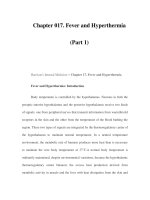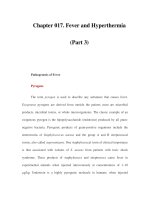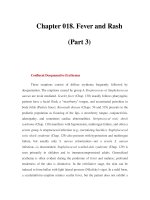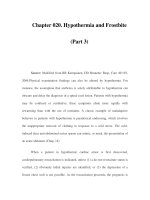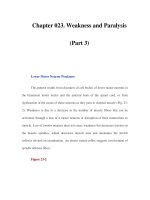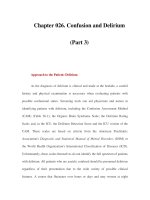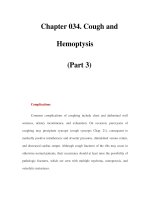Chapter 059. Bleeding and Thrombosis (Part 3) docx
Bạn đang xem bản rút gọn của tài liệu. Xem và tải ngay bản đầy đủ của tài liệu tại đây (69.03 KB, 5 trang )
Chapter 059. Bleeding and Thrombosis
(Part 3)
Sites of action of the four major physiologic antithrombotic pathways:
antithrombin (AT); protein C/S (PC/PS); tissue factor pathway inhibitor (TFPI);
and the fibrinolytic system, consisting of plasminogen, plasminogen activator
(PA), and plasmin. PT, prothrombin; Th, thrombin; FDP, fibrin(ogen) degradation
products. [Modified from BA Konkle, AI Schafer, in DP Zipes et al (eds):
Braunwald's Heart Disease, 7th ed. Philadelphia, Saunders, 2005.]
Antithrombin (or antithrombin III) is the major plasma protease inhibitor of
thrombin and the other clotting factors in coagulation. Antithrombin neutralizes
thrombin and other activated coagulation factors by forming a complex between
the active site of the enzyme and the reactive center of antithrombin. The rate of
formation of these inactivating complexes increases by a factor of several
thousand in the presence of heparin. Antithrombin inactivation of thrombin and
other activated clotting factors occurs physiologically on vascular surfaces, where
glycosaminoglycans, including heparan sulfates, are present to catalyze these
reactions. Inherited quantitative or qualitative deficiencies of antithrombin lead to
a lifelong predisposition to venous thromboembolism.
Protein C is a plasma glycoprotein that becomes an anticoagulant when it is
activated by thrombin. The thrombin-induced activation of protein C occurs
physiologically on thrombomodulin, a transmembrane proteoglycan binding site
for thrombin on endothelial cell surfaces. The binding of protein C to its receptor
on endothelial cells places it in proximity to the thrombin-thrombomodulin
complex, therefore enhancing its activation efficiency. Activated protein C acts as
an anticoagulant by cleaving and inactivating activated factors V and VIII. This
reaction is accelerated by a cofactor, protein S, which, like protein C, is a
glycoprotein that undergoes vitamin K–dependent posttranslational modification.
Quantitative or qualitative deficiencies of protein C or protein S, or resistance to
the action of activated protein C by a specific mutation at its target cleavage site in
factor Va (Factor V Leiden), lead to hypercoagulable states.
Tissue factor pathway inhibitor (TFPI) is a plasma protease inhibitor that
regulates the TF-induced extrinsic pathway of coagulation.
TFPI inhibits the
TF/FVIIa/FXa complex, essentially turning off the TF/FVIIa initiation of
coagulation, which then becomes dependent on the "amplification loop" via FXI
and FVIII activation by thrombin. TFPI is bound to lipoprotein and can also be
released by heparin from endothelial cells, where it is bound to
glycosaminoglycans, and from platelets. The heparin-mediated release of TFPI
may play a role in the anticoagulant effects of unfractionated and low-molecular-
weight heparins.
The Fibrinolytic System
Any thrombin that escapes the inhibitory effects of the physiologic
anticoagulant systems is available to convert fibrinogen to fibrin. In response, the
endogenous fibrinolytic system is then activated to dispose of intravascular fibrin
and thereby maintain or reestablish the patency of the circulation. Just as thrombin
is the key protease enzyme of the coagulation system, plasmin is the major
protease enzyme of the fibrinolytic system, acting to digest fibrin to fibrin
degradation products. The general scheme of fibrinolysis is shown in Fig. 59-4.
Figure 59-4
A schematic diagram of the fibrinolytic system. Tissue plasminogen
activator (tPA) is released from endothelial cells, binds the fibrin clot, and
activates plasminogen to plasmin. Excess fibrin is degraded by plasmin to distinct
degradation products (FDPs). Any free plasmin is complexed with α
2
-antiplasmin
(α
2
Pl).
The plasminogen activators, tissue type plasminogen activator (tPA) and
the urokinase type plasminogen activator (uPA), cleave the Arg560-Val561 bond
of plasminogen to generate the active enzyme plasmin. The lysine-binding sites of
plasmin (and plasminogen) permit it to bind to fibrin, so that physiologic
fibrinolysis is "fibrin specific." Both plasminogen (through its lysine-binding sites)
and tPA possess specific affinity for fibrin and thereby bind selectively to clots.
The assembly of a ternary complex, consisting of fibrin, plasminogen, and tPA,
promotes the localized interaction between plasminogen and tPA and greatly
accelerates the rate of plasminogen activation to plasmin. Moreover, partial
degradation of fibrin by plasmin exposes new plasminogen and tPA binding sites
in carboxy-terminus lysine residues of fibrin fragments to enhance these reactions
further. This creates a highly efficient mechanism to generate plasmin focally on
the fibrin clot, which then becomes plasmin's substrate for digestion to fibrin
degradation products.
Plasmin cleaves fibrin at distinct sites of the fibrin molecule leading to the
generation of characteristic fibrin fragments during the process of fibrinolysis
(Fig. 59-2). The sites of plasmin cleavage of fibrin are the same as those in
fibrinogen. However, when plasmin acts on covalently cross-linked fibrin, D-
dimers are released; hence, D-dimers can be measured in plasma as a relatively
specific test of fibrin (rather than fibrinogen) degradation. D-Dimer assays can be
used as sensitive markers of blood clot formation, and some have been validated
for clinical use to exclude the diagnosis of deep venous thrombosis (DVT) and
pulmonary embolism in selected populations.
Physiologic regulation of fibrinolysis occurs primarily at two levels: (1)
plasminogen activator inhibitors (PAIs), specifically PAI1 and PAI2, inhibit the
physiologic plasminogen activators; and (2) α
2
antiplasmin inhibits plasmin. PAI1
is the primary inhibitor of tPA and uPA in plasma. α
2
antiplasmin is the main
inhibitor of plasmin in human plasma, inactivating any nonfibrin clot–associated
plasmin.
